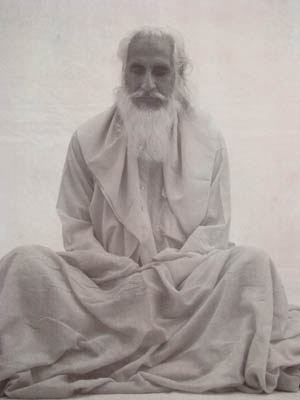The Art of Meditation
"Meditation can be described as an art of seeing without the interference of one's conditioned mind. Withdraw your attention from all the objects, situations, relationships and look within yourself. This is meditation."
- Shri Chandra Swami Udasin

Swamiji classifies the different methods of meditation which are practiced in different spiritual and religious traditions into three basic categories: The negative method, the positive method, and the witnessing method. The negative method involves rejecting all thoughts and emotions which arise in the mind during meditation. The positive method involves using a support, such as any one single name/mantra, form, or idea connected with the Divine/God to concentrate the mind upon, in order to make it one-pointed and silent. The witnessing method involves simply observing the mind and whatsoever thoughts, images or emotions that may arise in it, as a detached witness without getting involved. All these methods of meditation are described in detail in Swamiji's book, "The Practical Approach to Divinity." According to Swamiji, all these methods are capable of making the mind silent and peaceful, thus leading to Realization. But he places special emphasis on the efficacy and importance of self-surrender and prayer along with self-effort in one's spiritual path.
Swamiji on Meditation:
"Through meditation one does not accomplish anything new. Through meditation one only discovers one's essential Being, one's essential and true centre."
"Learning meditation is like learning to swim. You cannot learn swimming only by reading books or hearing lectures on swimming. How do you learn to swim? You get into the water — not so deep that you might drown, but enough that you can keep your head above the water. Similarly, for learning meditation you have to sit and try to keep yourself, as it were, above your thoughts and sensations. And for that you have to be alert and vigilant that you don't become identified with any thought or any sensation. Alertness is the master key in all the techniques of meditation."
"Meditation is sitting near God consciously, like a lover is sitting near his or her Beloved. No one can fall asleep when one is sitting with his/her beloved and they are enjoying sweet talk between themselves. Am I right? Let God be your Beloved, and during meditation, sit with Him.”
"Spiritual concentration implies the gathering together of all the dispersed powers and capacities of the being and focusing them on the Divine for the sole purpose of realizing Him first-hand."
"Your mind is like a mirror in which you see your face. When the mirror is dirty, you cannot see your face clearly. Similarly, when your mind is moving and impure, you cannot know who you really are. The purpose of meditation is to purify your mind and stop its modifications so that you may be aware of your own essential Being and be established in It."
"To know yourself, the direction of the attention has to be turned one hundred and eighty degrees. From the seen, the attention has to turn to the Seer; this is what Jung calls, “The backward flowing of Consciousness.” The theory behind all methods of meditation is first to separate the Seer from what is seen."
"There are many stages of meditation. In non-polar meditation, the subject and the object, the observer and the observed become one. In non-polar meditation only Awareness without any content remains."
"The purpose of spiritual contemplation is to take us beyond the mind to the direct supramental vision of the Divine. The process of perfect contemplation leads us to a strainless and stressless relaxation in the divine Spirit, or to an effortless absorption in the Seer which shines in Its pure light in the deep silence, where the mental activities of thinking, willing, knowing and feeling do not exist at all."
"To attain mental peace is not the final aim or highest achievement of meditation. Mental peace, attainment of real silence, or the state of thoughtlessness is just one step on the spiritual path. There are so many higher spiritual experiences above and beyond this. And the final experience is God-Realization, to fully attain God, to reside in God, to meet God, to drown in God, to merge in God like the wave completely merges back into its source, the ocean. The ultimate aim of meditation is to merge in God, who is infinite Bliss, infinite Consciousness, infinite Love, infinite Light, and infinite Existence."
Swamiji on Japa:
"Repetition is involved in every event and movement of this world. Japa is a technique to reach the subconscious through the repetition of a word or an idea. Japa itself is a sort of meditation. It is a dynamic meditation. It leads to the ultimate spiritual Experience and Realization of the Divine. The purpose of mantra japa is to remember the Divine through the mantra with a heart full of love. Mantra japa also purifies the subconscious mind of the seeker."
"In the practice of mantra japa, the power of the mantra first brings up what is buried in the subconscious. So if negative thoughts come up during japa, one should not be frightened. For example, if you start sweeping a room, the dust which has settled in the room will start flying. You should not be frightened by it and should not stop sweeping. The power of the mantra will destroy those negative thoughts after bringing them up."
"Mantra japa is also a means to fall in love with God. If you are constantly remembering God through repeating His name, you are bound to fall in love with God eventually. Whatever you are thinking or remembering continuously, you become attached with. It may be a thing, person or situation. Japa means repetition. Constant repetition of any idea (every word or mantra is associated with an idea) transforms your mind, your outlook, your life and your values of life. It is a psychological fact."

